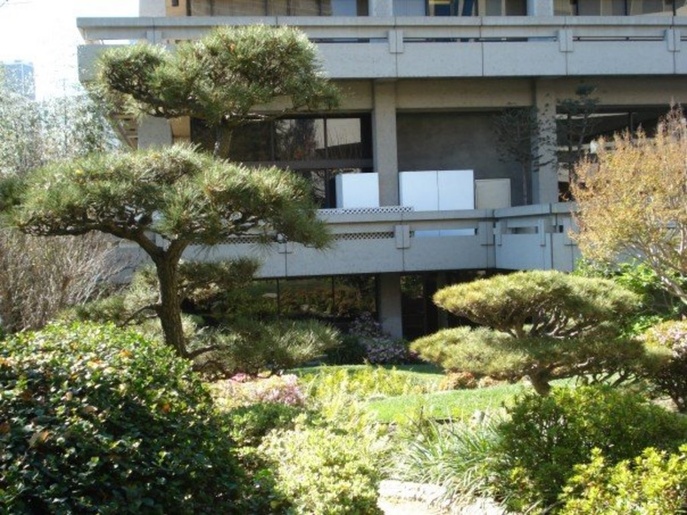James Irvine Garden

|
||
| Licensing | ||
Completed in 1979, the James Irvine Garden, also known as Seiryu-en, “Garden of the Clear Stream,” is an 8,500 square foot garden built in conjunction with the Japanese American Cultural and Community Center in the heart of Los Angeles’ Little Tokyo. The garden was designed by Takeo Uesugi and funded in large part by a grant from James Irvine, hence the name. In 1981, it received the National Landscape Award, the nation’s oldest and most prestigious environmental improvement and beautification award, from the American Association of Nurserymen.
By virtue of its location and affiliation with the JACCC, one can assume that the James Irvine Garden was built, at least in part, to serve as a centralized gathering space for the Japanese American community. However, though the space is available for weddings, filming and photo shoots, its centrality does not seem at all assured. The garden itself is located on the edge of the JACCC, wedged in a corner between the George and Sakaye Aratani Japan America Theatre and the JACCC Center Building. A visit to the garden, now surrounded by apartment complexes on its remaining sides, evokes a feeling of stepping into someone’s backyard, as the entrance is unattended and unadorned. A weekday visit reveals only a few visitors, mainly older Japanese American men playing Chinese checkers.
The physical condition of the garden serves to further question the centrality of the garden to the Japanese community, though, as will be discussed below, this may also serve to increase the garden’s authenticity. Even to a non-gardener, the garden appears to be in decline. Weeds grow in and among the plants and rocks, and branches of plants have been allowed to grow over bridge railings, impeding the visitor’s walking path. The water in the pond appears slightly stagnant.
This state of physical disrepair, combined with the knowledge that the garden was built to serve as part of a central community center, leads one to wonder what this says about the Japanese American community. Does this disrepair mean that the generation which built and maintained this garden are too old to continue their work, and the younger generation has little or no interest in following their footsteps? Or does it mean that the Japanese American community as a whole no longer sees the need for a central gathering place?
Another aspect of this physical disrepair, however, relates to the idea of authenticity. Many gardens are meticulously cared for to provide the visitor with a picture-perfect, yet supposedly natural experience. Many Japanese gardens are promoted as places of harmony, tranquility and serenity, yet their carefully manicured plants and deliberately placed sculptures can serve to offset the feeling of naturalness, rather than recreate it. Further, some of these gardens are more economic endeavors than environmental ones, using the label of “Japanese” garden as an excuse to sell things like origami paper in their gift shops. Thus, one can look at the state of the James Irvine Garden not as disrepair, but as an attempt to create a more authentic recreation of nature.
In her article, “Reinventing Culture,” Carla Tengan discusses how nostalgia of an increasingly urban population for a more natural past has made gardens more essential to maintaining a balance between what is built and what is natural (22). Presented by the JACCC website as “an oasis in the central city,” the James Irvine Garden is certainly portrayed as a place where who Tengan calls “urbanites and suburbanites yearning for day-trips to the country, woods, mountains or beaches in order to reconnect with that contemplative side (22)” can take a break from their hectic daily lives and rejuvenate their minds and spirits. Depending on the way one interprets the current state of the garden, one can argue either that this nostalgia has dissipated or perhaps been completely submerged by a relentless tide of urbanization (hence, no one cares about the upkeep of the garden), or that this nostalgia has sharpened with continued urbanization (so the groundskeeper(s) are trying to create an even more natural environment).

This work is licensed under a Creative Commons Attribution-No Derivative Works 2.5 License
Album Type
online exhibition
 jdecker
—
Last modified Jun 28 2021 1:49 a.m.
jdecker
—
Last modified Jun 28 2021 1:49 a.m.














 vkm
vkm


 mpitelka
mpitelka

 James Irvine Garden
James Irvine Garden
 Journal feed
Journal feed
